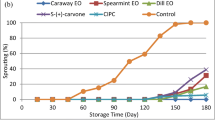Summary
The effects of 10 volatile oils and their main compounds on potato sprout growth were investigated in vitro. Sprout growth was inhibited especially by the volatile oils fromOriganum onites, Rosa damascena, Carum carvi, Mentha piperita, Echinophora tuneifolia andCoriandrum sativum. The major compound of volatile oils was carvacrol (78.2%) inO. onites, citronellol (46.7%) inR. damascena, S-(+)-carvone (54.9%) inC. carvi, menthol (44.1%) inM. piperita, α phelladrene (45.9%) inE. tuneifolia and linalool (76.5%) inC. sativum. The results showed that some volatile oils rich in monoterpenic compounds such as carvacrol, citronellol, geraniol, nerol and S-(+)-carvone were able to prevent the growth of sprouts and extend the storage-life of the potato tubers.
Similar content being viewed by others
References
Aligiannis, N., E. Kalpoutzakis, S. Mitaku & I.B. Chinou, 2001. Composition and antimicrobial activity of the essential oils twoOriganum species.Journal of Agricultural and Food Chemistry 49: 4168–4170.
Beveridge, J.L., J. Dalziel & H.J. Duncan, 1983. Headspace analysis of laboratory samples of potato tubers treated with 1,4-dimethylnaptalene, carvone, pulegone and citral.Journal of Science of Food and Agriculture 34: 164–168.
Cowan, M.M., 1999. Plant products as antimicrobial agents.Clinical Microbiology Reviews 12: 564–582.
Cosentino, S., C.I.G. Tuberoso, B. Pisano, M. Satta, V. Mascia, E. Arzedi & F. Palmas, 1999. In-vitro antimicrobial activity and chemical composition of SardinianThymus essential oils.Letters in Applied Microbiology 29: 130–135.
Dorman, H.J.D. & S.G. Deans, 2000. Antimicrobial agents from plants: antibacterial activity of plant volatile oils.Letters in Applied Microbiology 88: 308–316.
Hammer, K.A., C.F. Carson & T.V. Riley, 1999. Antimicrobial activity of essential oils and other plant extracts.Journal of Applied Microbiology 86: 985–990.
Hartmans, K.J., P. Diepenhorst, W. Bakker & L.G.M. Gorris, 1995. The use of carvone in agriculture: sprout suppression of potatoes and antifungal activity against potato tuber and other plant diseases.Industrial Crops and Products 4: 3–13.
Kerstolt, R.P.V., CM. Ree & H.C. Moll, 1997. Environmental life cycle of potato sprout inhibitors.Industrial Cops and Products 6: 187–194.
Meigh, D.F., 1969. Suppression of sprouting in stored potatoes by volatile organic compounds.Journal of Science of Food and Agriculture 20: 159–164.
Murashige, T. & G. Skoog 1962. A revised medium for rapid growth and bioassays with tobacco tissue cultures.Journal of Plant Physiology 15: 473–497.
Oosterhaven, K., K.J. Hartmans & H.J. Huizing, 1993. Inhibition of potato (Solanum tuberosum) sprout growth by the monoterpene S-carvone: reduction of 3-hydroxy-3-methylglutaryl coenzyme A reductase activity without effect on its mRNA level.Journal of Plant Physiology 141: 463–469.
Oosterhaven, K., B. Poolman & E.J. Smid, 1995. S-Carvone as a natural potato sprout inhibiting, fungistatic and bacteritatic compound.Industrial Crops and Products 4: 23–31.
Panizi, L., G. Flamini, P.L. Cioni & I. Morelli, 1993. Composition and antimicrobial properties of essential oils of four MediterraneanLamiaceae.Journal of Ethnopharmacology 39:167–170.
Roca, W.N., N.O. Espinoza, M.R. Roca & J.E. Bryan, 1978. A tissue culture method for the rapid propagation of potatoes.American Potato Journal 55: 661–671.
Sivropoulou, A., E. Papanikolaou, C. Nikolaou, S. Kokkini, T. Lanaras & M. Arsenakis, 1996. Antimicrobial and cytotoxic activities ofOriganum essential oils.Journal of Agricultural and Food Chemistry 44: 1202–1205.
Taiz, L. & E. Zeiger, 1998. Plant defences: surface protectants and secondary metabolites Gibberellins: In: Plant Physiology (2nd Ed.), Sinauer Assoc, Inc., Pub., Sunderland, Massachusetts, USA, pp. 347–376.
Vaughn, S.F. & G.F. Spencer, 1991. Volatile monoterpenes inhibit potato tuber sprouting.American Potato Journal 68: 821–831.
Vokou, D., S. Vereltzidou & P. Katinakis, 1993. Effects of aromatic plants on potato storage: sprout suppression and antimicrobial activity.Agriculture, Ecosystems and Environment 47: 223–235.
Author information
Authors and Affiliations
Corresponding author
Rights and permissions
About this article
Cite this article
Baydar, H., Karadoğan, T. The effects of volatile oils on in vitro potato sprout growth. Potato Res 46, 1–8 (2003). https://doi.org/10.1007/BF02736098
Accepted:
Issue Date:
DOI: https://doi.org/10.1007/BF02736098




